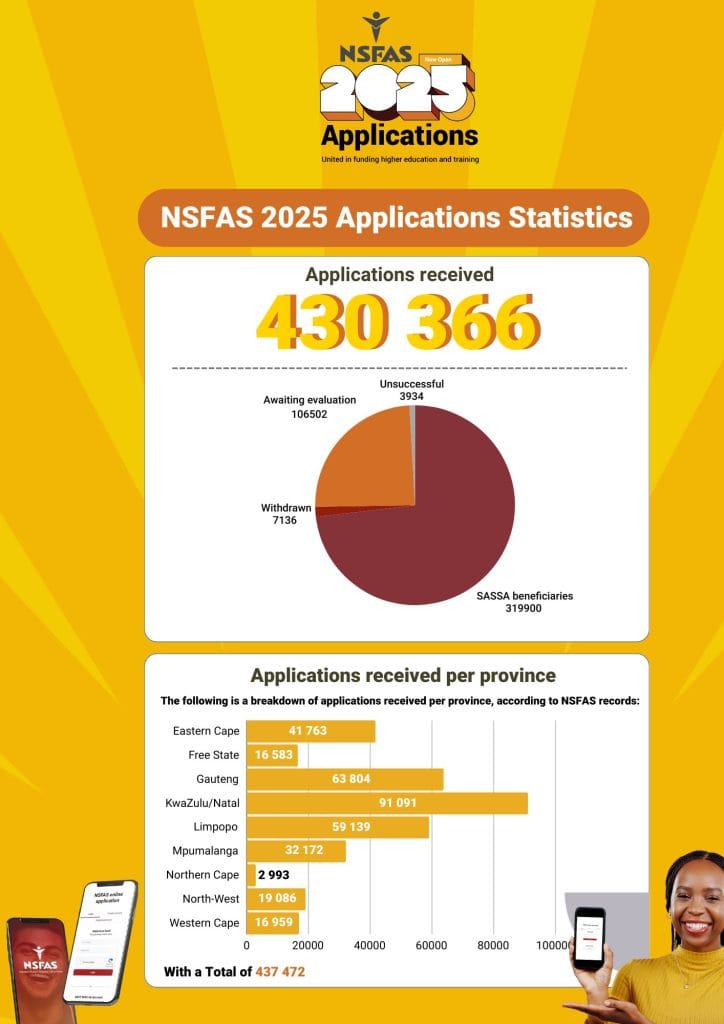NSFAS HAS RELEASED ITS LATEST STATISTICS ON THE 2025 NSFAS APPLICATION, and the numbers reveal a critical reality: more students than ever before are seeking financial assistance to pursue higher education. The National Student Financial Aid Scheme (NSFAS) plays a pivotal role in providing support for students who come from low-income households, and the sheer number of applications for 2025 reflects the country’s ongoing economic challenges.
With over 430,366 applications already submitted, it is clear that NSFAS is more than just a financial aid program—it’s a lifeline for many South African students.
NSFAS 2025: A Closer Look at the Numbers
The latest data on NSFAS 2025 Applications provides crucial insight into how many students depend on the scheme to further their studies. Here’s a detailed breakdown of the key figures:
- 319,900 applicants are SASSA (South African Social Security Agency) beneficiaries, indicating that a large proportion of applicants come from the country’s poorest households. For these students, NSFAS is often their only hope of accessing higher education.
- 106,502 applications are still awaiting evaluation, highlighting the significant workload that NSFAS faces in processing these requests.
- Unfortunately, 3,934 applications have been unsuccessful, meaning these students will have to seek alternative funding sources if they wish to pursue their studies.
- 7,136 applicants have chosen to withdraw their applications, which could be due to various reasons, including the possibility of finding other sources of funding.
With such a vast number of applications, NSFAS’s capacity to meet the growing demand for financial support will be tested as the 2025 academic year approaches. The situation paints a vivid picture of the financial struggles facing many South African families and students.

Provincial Breakdown: Where Are the Applications Coming From?
A closer look at the provincial distribution of the NSFAS 2025 Applications offers insight into where the demand for financial aid is most concentrated:
- KwaZulu-Natal leads with 91,091 applications, the highest in the country. This is reflective of the province’s large student population and the significant socio-economic challenges it faces.
- Gauteng, the country’s wealthiest province and its economic center, follows with 63,804 applications. Despite its economic status, the high number of applicants shows that many families in Gauteng still struggle to afford tertiary education.
- Limpopo has 59,139 applications, demonstrating a strong need for financial support in a province often associated with rural and underdeveloped areas.
- Eastern Cape, another province with widespread poverty, has contributed 41,763 applications.
- Mpumalanga comes next with 32,172 applications, highlighting the demand for higher education funding in this rural province.
- Other provinces include:
- Free State: 16,583 applications
- Western Cape: 16,959 applications
- North West: 19,086 applications
- Northern Cape: 2,993 applications
In total, NSFAS received 437,472 applications from across the country. This distribution reflects both the population size of each province and the economic challenges students in these regions face.
Related: Top In-Demand Careers You Can Pursue with NSFAS Funding in 2025
The Challenge of Processing Thousands of Applications
The large number of 2025 Applications presents a challenge for the scheme. With over 106,502 applications still awaiting evaluation, NSFAS has a significant task ahead. Students are urged to remain patient as their applications are processed, but delays could lead to uncertainty for many who are still awaiting their results.
In addition, with 3,934 unsuccessful applications, it’s crucial for NSFAS to ensure that the evaluation process is both fair and transparent. Students who are denied funding must have the opportunity to appeal or be directed to alternative sources of funding, such as scholarships or bursaries.
Moreover, the withdrawal of 7,136 applications points to potential difficulties students may face during the application process, whether due to technical issues, a lack of understanding about the requirements, or finding other sources of financial support. NSFAS should continue to provide clear communication and support to ensure that students don’t miss out on funding due to avoidable obstacles.
Alternatives for Students Who Miss Out
While NSFAS provides a critical source of funding, not all students will qualify or secure financial aid through the scheme. For those who miss out on NSFAS funding, it’s important to explore other options:
- Government Bursaries: Many government departments offer bursaries for specific fields of study, such as engineering, teaching, and medicine. Students should research these opportunities as an alternative to NSFAS.
- Private Scholarships: Numerous private companies and organizations offer scholarships to deserving students, often based on academic merit or financial need. It’s worth applying to multiple scholarships to increase the chances of securing funding.
- Part-time Work and Study Loans: For some students, working part-time while studying or applying for student loans from financial institutions may be necessary to cover costs. While this may not be the ideal solution for everyone, it can be a viable option for students who are not able to secure other forms of funding.
More: How to Protect Yourself from Scammers during the 2025 Application Period
What to Expect Moving Forward
For students who have submitted their NSFAS 2025 Applications, the next step is to wait for the evaluation process to be completed. As thousands of applications are still under review, students are encouraged to check their application status regularly on the NSFAS portal. In the meantime, ensuring that all necessary documentation has been submitted will help avoid any further delays.
For those who have been unsuccessful, it’s important to take action quickly. NSFAS typically allows students to appeal the decision if they believe their application was wrongly rejected or if their circumstances have changed. Students are urged to follow the appeals process carefully and provide any additional information required.
Conclusion: NSFAS as a Catalyst for Change
The NSFAS 2025 Applications demonstrate the deep need for financial support among South African students. As the country grapples with economic challenges, NSFAS continues to provide a vital lifeline for students who would otherwise be unable to afford higher education.
By offering funding to students from low-income households, particularly SASSA beneficiaries, NSFAS is not only helping individuals achieve their academic goals but also contributing to the country’s broader economic development. Through education, these students can gain the skills and qualifications necessary to participate in the workforce and uplift their families and communities.
The challenge moving forward will be ensuring that NSFAS can continue to meet the growing demand for financial aid and that students are supported throughout the application process. For now, the focus remains on processing the thousands of applications and ensuring that those who qualify for funding receive the support they need to pursue their studies.









